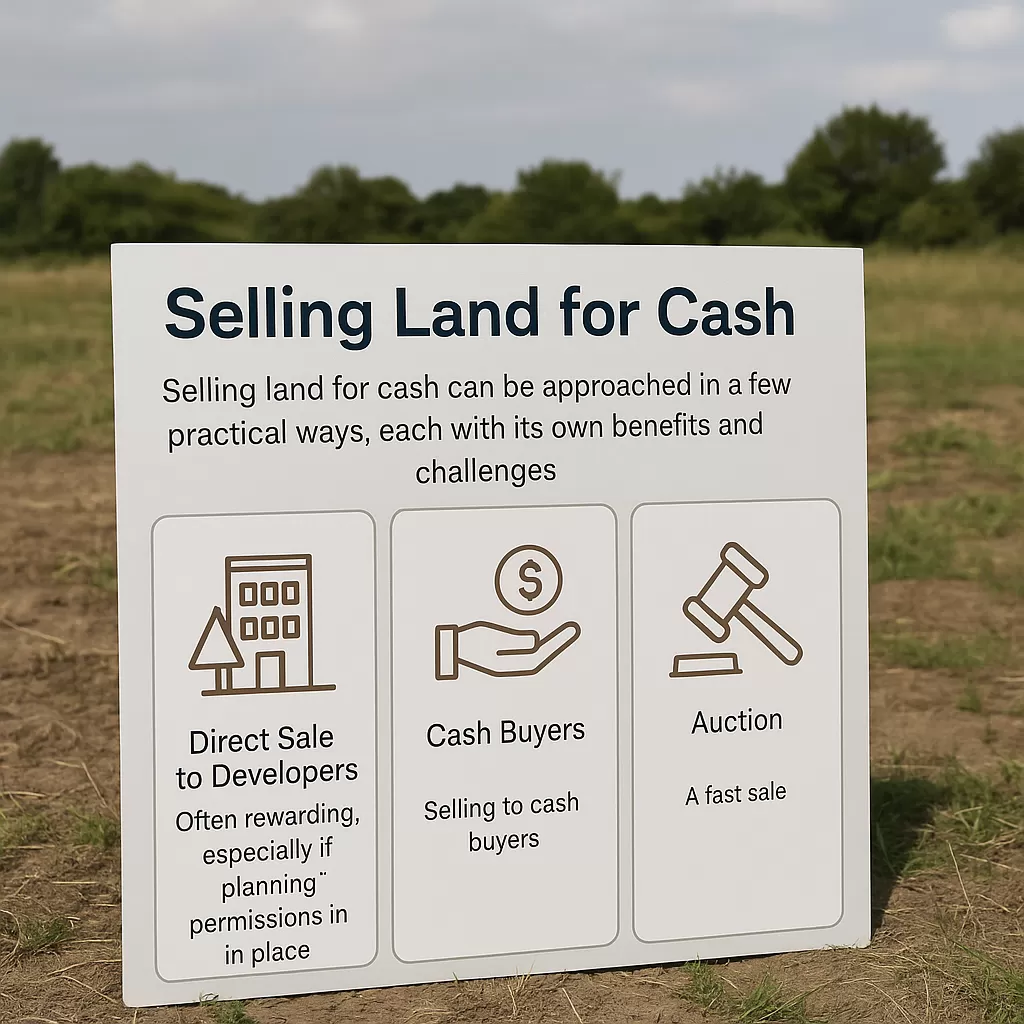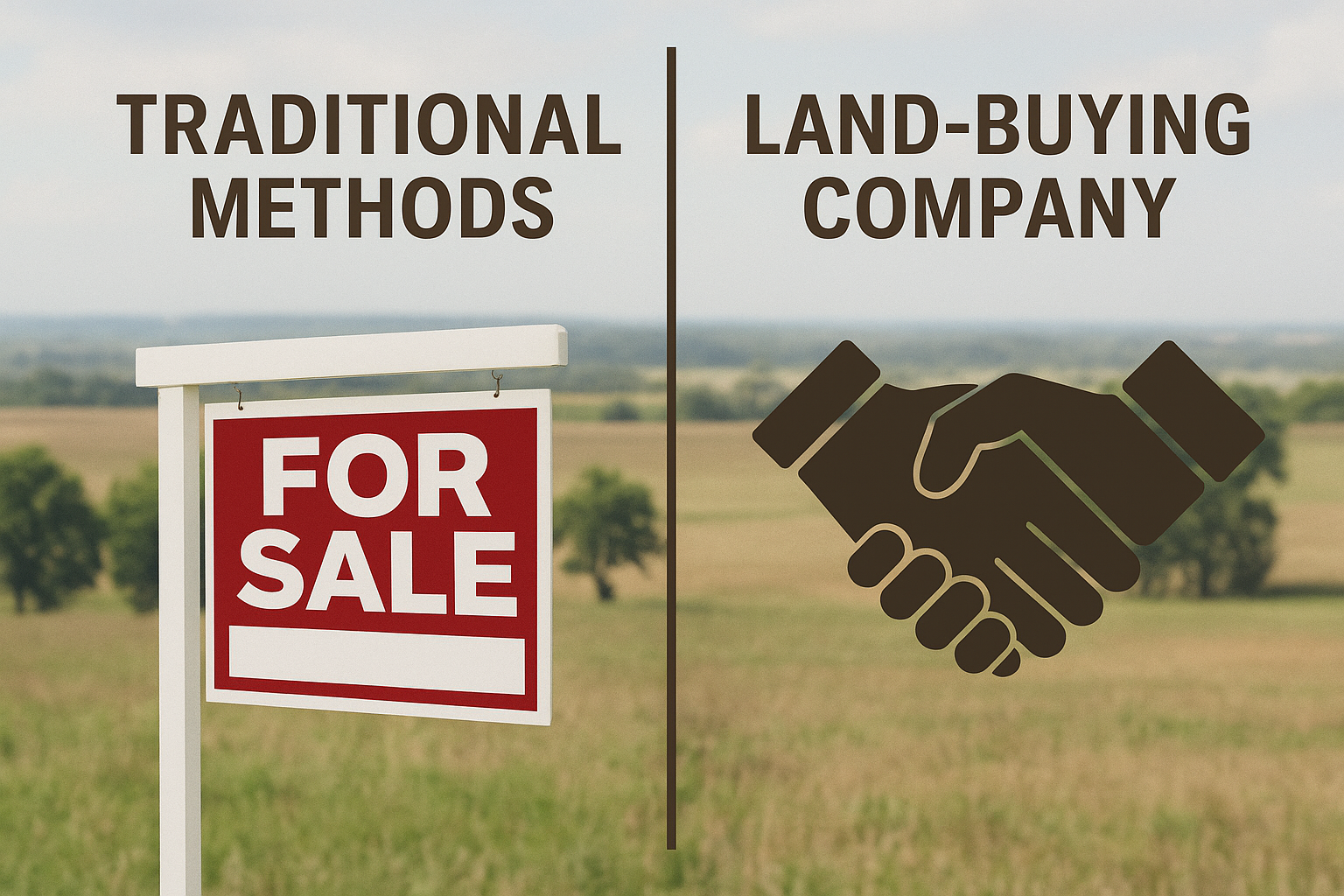Planning permission can dramatically transform the value of land, often increasing it by several multiples of its agricultural or amenity worth. For landowners looking to sell, understanding and navigating the planning system effectively can be the difference between a standard sale and an exceptional return. This comprehensive guide explores the relationship between planning permission and land value, strategies for enhancing planning potential, and approaches for marketing land at different stages of the planning journey.
Understanding Planning Permission and Land Value The connection between planning status and market value is fundamental to land sales.
The Planning Value Ladder
Different levels of planning certainty create a value hierarchy:
- Agricultural or amenity land: Base value without development potential
- Strategic land: Identified in local plans but without specific permission
- Allocation status: Formally designated for development in adopted plans
- Outline planning permission: Basic approval for development principle
- Detailed planning permission: Specific approval for defined schemes
- Implementable permission: All conditions discharged and ready for development
Each step up this ladder typically increases value significantly, with the most dramatic jumps occurring when land moves from agricultural to allocated status and from allocation to outline permission.
Value Multipliers by Permission Type
Understanding potential value enhancement:
- Agricultural to outline residential: Typically 10-100+ times increase depending on location
- Agricultural to outline commercial: Generally 5-50 times increase based on use type
- Outline to detailed permission: Usually 10-30% additional value
- Detailed to implementable: Typically 5-15% further increase
- Permission with affordable housing: Value impact of different obligation levels
- Permission with infrastructure requirements: How contribution demands affect value
- Permission with design constraints: Impact of quality and density requirements
- Permission with phasing limitations: How development timing affects present value
These multipliers vary significantly by location, with the highest increases in areas of strong housing demand and limited supply.
Risk/Reward Relationship
How uncertainty affects achievable prices:
- Speculative land: Heavily discounted for planning risk
- Promotion agreement land: Value shared based on planning success
- Option agreement land: Price contingent on permission achievement
- Outline permission land: Discounted for remaining reserved matters risk
- Detailed permission land: Reduced for discharge of conditions uncertainty
- Ready-to-develop land: Premium for immediate implementation potential
- Serviced plots: Maximum value with minimal remaining risk
- Planning risk pricing: How the market quantifies uncertainty
Understanding this relationship helps landowners make informed decisions about timing and investment in planning.
Pre-Sale Planning Strategies
Several approaches can enhance planning status before marketing.
Local Plan Engagement
Influencing strategic planning policy:
- Local plan monitoring: Tracking review and update schedules
- Call for sites response: Submitting land for consideration during plan preparation
- Representation submission: Formal comments during consultation periods
- Evidence base contribution: Providing supporting information for allocation
- Sustainability demonstration: Showing how the site meets policy objectives
- Comparative advantage emphasis: Highlighting benefits versus alternative sites
- Coalition building: Working with other stakeholders to support allocation
- Expert representation: Engaging planning consultants for professional submissions
Effective local plan engagement can secure allocation without the cost of complete applications.
Pre-Application Consultation
Testing development potential before formal submission:
- Authority engagement: Preliminary discussions with planning officials
- Feedback incorporation: Addressing initial concerns in evolving proposals
- Design development: Refining schemes based on pre-application guidance
- Technical issue identification: Early discovery of potential obstacles
- Policy compliance confirmation: Verifying alignment with local requirements
- Stakeholder introduction: Beginning dialogue with key decision influencers
- Application pathway clarification: Determining optimal permission route
- Written advice securing: Obtaining documented pre-application opinions
Pre-application consultation reduces uncertainty and demonstrates serious development intention.
Outline Planning Application

Securing basic development approval:
- Development parameter definition: Establishing key metrics like units or square footage
- Access arrangement specification: Defining how the site will be entered
- Illustrative masterplan creation: Showing potential development approach
- Supporting study commissioning: Providing technical evidence for viability
- Policy compliance demonstration: Showing alignment with planning requirements
- Consultation response management: Addressing stakeholder feedback
- Committee presentation preparation: Creating a compelling case for approval
- Condition negotiation: Limiting onerous requirements where possible
Outline permission significantly increases value while leaving flexibility for purchasers.
Planning Performance Agreement
Structured approach for complex applications:
- Timeline establishment: Agreeing processing schedules with authorities
- Resource commitment: Securing dedicated planning officer time
- Meeting structure creation: Organizing regular progress reviews
- Issue resolution protocol: Establishing how challenges will be addressed
- Expert input coordination: Organizing technical consultant involvement
- Decision pathway mapping: Clarifying route to determination
- Fee arrangement negotiation: Agreeing costs for enhanced service
- Milestone definition: Setting clear progress checkpoints
PPAs provide greater certainty for significant applications, reducing timeline risk.
Marketing Strategies for Different Planning
Stages How to position land based on its current planning status.
Strategic Land Marketing
Selling land with future potential but no current permission:
- Local plan status emphasis: Highlighting policy support for development
- Sustainability narrative creation: Demonstrating location advantages
- Constraint absence verification: Confirming lack of major obstacles
- Comparable site reference: Pointing to similar land with permission success
- Vision development: Creating a compelling future development story
- Technical feasibility demonstration: Showing practical development potential
- Target audience identification: Reaching appropriate strategic land buyers
- Long-term opportunity framing: Setting realistic timeline expectations
Strategic land marketing focuses on future potential rather than immediate development.
Outline Permission Marketing
Promoting land with basic development approval:
- Permission detail emphasis: Highlighting approved development parameters
- Remaining flexibility demonstration: Showing scope for purchaser influence
- Technical due diligence preparation: Compiling supporting studies and reports
- Condition discharge pathway: Outlining steps to implementation
- Development capacity confirmation: Verifying achievable density and units
- Viability evidence provision: Demonstrating financial feasibility
- Implementation timeline projection: Realistic schedule for development
- Reserved matters approach suggestion: Potential strategies for detailed design
Outline permission marketing balances certainty of principle with flexibility of detail.
Detailed Permission Marketing
Selling land with specific scheme approval:
- Scheme quality emphasis: Highlighting design excellence and marketability
- Technical approval verification: Confirming all design details are resolved
- Condition status clarification: Explaining which requirements are satisfied
- Implementation readiness demonstration: Showing the path to immediate development
- Market alignment evidence: Proving scheme meets current demand
- Construction cost verification: Providing detailed build cost assessments
- Phasing opportunity explanation: Showing delivery flexibility where applicable
- End product visualization: High-quality imagery of approved development
Detailed permission marketing focuses on implementation speed and quality assurance.
Implementable Permission Marketing
Promoting fully approved, ready to develop land:
- Immediate start potential: Emphasizing the ability to commence construction
- All approvals verification: Confirming complete regulatory compliance
- Technical pack comprehensiveness: Providing complete construction information
- Service connection confirmation: Verifying utility availability and capacity
- Site preparation status: Explaining any clearance or remediation completed
- Section 106 discharge: Confirming satisfaction of legal obligations
- Community relationship status: Describing local stakeholder position
- Development partner introduction: Potential connections to builders or contractors
Implementable permission marketing commands premium pricing for certainty and speed.
Working with Planning Professionals
Expert assistance significantly impacts planning outcomes.
Planning Consultant Selection
Choosing the right planning expertise:
- Local experience verification: Confirming familiarity with specific authorities
- Similar project track record: Checking history with comparable developments
- Authority relationship assessment: Evaluating connections with decision-makers
- Technical capability evaluation: Assessing the ability to address specific challenges
- Communication skill verification: Confirming clear explanation capability
- Team composition review: Understanding who will handle the work
- Fee structure transparency: Clarifying cost basis and potential variables
- Success rate investigation: Checking percentage of approved applications
The right planning consultant significantly increases permission probability.
Technical Consultant Coordination
Managing specialized expertise effectively:
- Necessary discipline identification: Determining required specialist input
- Consultant selection criteria: Choosing appropriate experts for each area
- Brief development: Creating clear instructions for a consistent approach
- Information sharing protocol: Ensuring efficient data exchange
- Contradictory finding resolution: Process for addressing conflicting advice
- Integrated reporting approach: Creating cohesive rather than fragmented outputs
- Cost management strategy: Controlling specialist expenditure effectively
- Quality assurance process: Verifying technical work meets requirements
Effective coordination prevents contradictions and ensures comprehensive coverage.
Planning Lawyer Engagement
When to involve specialized legal expertise:
- Complex application support: Assistance with challenging proposals
- Appeal representation: Expert advocacy for refused applications
- Judicial review consideration: Evaluating challenges to adverse decisions
- Section 106 negotiation: Support with legal planning obligations
- Condition discharge disputes: Resolving disagreements about requirement satisfaction
- Enforcement challenge response: Addressing alleged planning breaches
- Planning committee representation: Professional advocacy at decision meetings
- Planning policy interpretation: Expert analysis of ambiguous requirements
Legal expertise is particularly valuable for contentious or high-value applications.
Alternative Permission Strategies

Several approaches can enhance value without complete planning applications.
Permitted Development Exploration
Utilizing development rights without full permission:
- Class Q agricultural conversion: Barn to residential dwelling rights
- Commercial to residential rights: Office and retail conversion potential
- Extension and alteration rights: Adding value through size increases
- Change of use opportunities: Switching between use classes
- Prior notification process: Streamlined approval for certain developments
- Permitted development limitations: Understanding restrictions and conditions
- Article 4 direction checking: Verifying no removal of standard rights
- Lawful Development Certificate application: Confirming permitted development status
Permitted development can offer faster, more certain routes to value enhancement.
Certificate of Lawfulness Strategy
Confirming existing use rights:
- Use history documentation: Gathering evidence of established activities
- Witness statement collection: Securing testimony about historical usage
- Documentary evidence compilation: Assembling bills, photos, and records
- Statutory declaration preparation: Formal sworn statements of fact
- Period verification: Confirming sufficient duration for immunity
- Continuous use demonstration: Proving unbroken activity chains
- Application strategy development: Creating compelling evidential case
- Authority negotiation approach: Addressing questions and concerns effectively
Established use rights can significantly enhance the value of certain property types.
Planning Appeal Consideration
Challenging refusal decisions:
- Appeal grounds assessment: Evaluating the strength of the potential challenge
- Procedure selection: Choosing between written, hearing, or inquiry routes
- Cost application potential: Assessing the possibility of expense recovery
- Timeline implication understanding: Recognizing delay impact on sale
- Success probability analysis: Realistic evaluation of outcome likelihood
- Enhanced scheme development: Addressing reasons for initial refusal
- Expert witness requirement: Identifying necessary specialist testimony
- Appeal strategy creation: Developing a compelling case for the inspector
Successful appeals can transform value but require careful cost-benefit analysis. Working with Specialized Land Buyers For landowners seeking certainty with fair planning value recognition:
Planning Potential Valuation
How specialized buyers assess development opportunities:
- Planning policy analysis: Professional evaluation of development likelihood
- Constraint assessment: Realistic appraisal of limiting factors
- Comparable permission reference: Drawing on similar successful sites
- Development capacity calculation: Determining realistic unit potential
- Planning risk quantification: Objective evaluation of permission probability
- Timeline projection: Realistic estimation of planning journey duration
- Cost implication understanding: Recognizing expenditure requirements
- Value sharing approach: Fair distribution of planning enhancement potential
Specialized buyers combine planning expertise with direct purchase capability.
Planning Risk Absorption
Transferring uncertainty to experienced developers:
- Risk transfer premium: Fair compensation for planning uncertainty
- Expertise application: Buyer applying specialized planning knowledge
- Resource commitment: Buyer investing in permission pursuit
- Timeline acceptance: Buyer absorbing duration uncertainty
- Cost assumption: Buyer covering planning application expenses
- Political engagement capability: Buyer managing stakeholder relationships
- Technical challenge resolution: Buyer addressing complex planning issues
- Alternative strategy implementation: Buyer pursuing multiple permission routes
This approach allows landowners to realize enhanced value without planning expertise or risk exposure.
Conclusion
Planning permission represents the single most significant factor in determining land value, often increasing worth by many multiples of agricultural or amenity levels. Landowners can maximize returns when selling land with development potential by understanding the planning system, implementing appropriate enhancement strategies, and marketing effectively based on current status.
Specialized land buying companies offer a compelling alternative for those seeking to realize enhanced value without navigating the complex planning process themselves. These buyers combine planning expertise with direct purchase capability, often recognizing and paying for planning potential without requiring landowners to secure permission.
Whether pursuing planning permission independently before sale or working with specialized land buyers who absorb planning risk, understanding the relationship between planning status and value is essential for maximizing returns from land with development potential.









